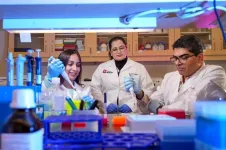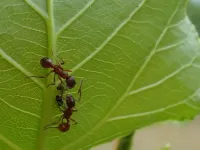(Press-News.org) INDIANAPOLIS- A team of scientists at the Indiana University School of Medicine has identified that an eye condition affecting the retina, the light-sensing tissue in the back of the eye, may serve as an early indicator for Alzheimer's disease. Their findings, published in Alzheimer's & Dementia, offer new insights into the potential use of retinal changes as early biomarkers for Alzheimer's, which could improve diagnosis and treatment of neurodegenerative disease.
The research was led by IU School of Medicine PhD Student Surabhi D. Abhyankar, MS, alongside colleagues from the school's departments of ophthalmology and biochemistry and molecular biology, the Stark Neurosciences Research Institute, and the Leslie Dan Faculty of Pharmacy at the University of Toronto. Their findings indicate that the presence of the APOE4 gene — known to increase the risk of Alzheimer's disease in humans — in mice impairs retinal function, suggesting a direct link between this genetic variant and visual processing deficits associated with Alzheimer's disease.
"The eye is a window to the brain reflecting changes associated with neurodegenerative conditions such as Alzheimer's disease, said Ashay Bhatwadekar, PhD, associate professor of ophthalmology and principal investigator of the study. "Nearly 7 million Americans are living with Alzheimer's disease, and our study will help provide ease of diagnosis and potential intervention for Alzheimer's disease, thus enhancing patient outcomes and quality of life in the future."
The research team used advanced imaging techniques to assess retinal structure and function in the mice. Compared to control groups, they observed significant alterations in retinal thickness and electrical activity in biological tissues and cells. These findings align with clinical observations of retinal abnormalities in Alzheimer's patients, reinforcing the relevance of this model for studying triggers of the disease.
"Our study demonstrates that retinal dysfunction occurs in the APOE4 mouse model, mirroring aspects of Alzheimer's pathology," Abhyankar said. "These results underscore the potential of retinal imaging as a non-invasive method to detect early neural changes in Alzheimer's disease."
Other study authors include Qianyi Luo, PhD; Gabriella D. Hartman, BS; Neha Mahajan, PhD; Timothy W. Corson, PhD; Adrian L. Oblak, PhD; and Bruce T. Lamb, PhD.
This research was supported by funding from the National Eye Institute and Research to Prevent Blindness.
About the Indiana University School of Medicine
The IU School of Medicine is the largest medical school in the U.S. and is annually ranked among the top medical schools in the nation by U.S. News & World Report. The school offers high-quality medical education, access to leading medical research and rich campus life in nine Indiana cities, including rural and urban locations consistently recognized for livability. According to the Blue Ridge Institute for Medical Research, the IU School of Medicine ranks No. 13 in 2023 National Institutes of Health funding among all public medical schools in the country.
For more news, visit the IU School of Medicine Newsroom: medicine.iu.edu/news
END
Researchers identify potential link between retinal changes, Alzheimer’s disease
2025-02-26
ELSE PRESS RELEASES FROM THIS DATE:
Hidden allies
2025-02-26
Endophytes: A plant’s friends or foes
Endophytes are microorganisms that live inside plants. Some of these organisms, mostly bacteria or fungi, make the plants sick, while others have no harmful effect on the plants or are even beneficial. Previous studies of endophytic fungi living inside certain grasses have shown that these fungi provide the grasses with a defense against predators. However, little has been known about whether this is also true for trees. The current study investigated the influence of an endophytic fungus of the genus Cladosporium on the herbivore defense of the black poplar Populus nigra, as well as the effects on the insect communities that live on poplars.
"We ...
HKUST unveils critical nanoscale phenomena for more efficient and stable perovskite solar cells
2025-02-26
In a significant advancement for boosting renewable energy generation development, the School of Engineering of the Hong Kong University of Science and Technology (HKUST) has taken the lead in breaking through studies of the nanoscale properties of perovskite solar cells (PSCs). This initiative has resulted in the development of more efficient and durable cells, poised to substantially diminish costs and broaden applications, thereby connecting scientific research with the needs of the business community.
Compared to conventional silicon solar ...
MD Anderson Research Highlights for February 26, 2025
2025-02-26
HOUSTON ― The University of Texas MD Anderson Cancer Center’s Research Highlights showcases the latest breakthroughs in cancer care, research and prevention. These advances are made possible through seamless collaboration between MD Anderson’s world-leading clinicians and scientists, bringing discoveries from the lab to the clinic and back.
Study identifies biomarkers for predicting treatment response in metastatic breast cancer
Standard treatment for patients with hormone receptor (HR)-positive, HER2-negative (HR+/HER2-) ...
Social media posts about medical tests with potential for overdiagnosis
2025-02-26
About The Study: In this cross-sectional study of social media posts about 5 popular medical tests, most posts were misleading or failed to mention important harms, including overdiagnosis or overuse. These data demonstrate a need for stronger regulation of misleading medical information on social media.
Corresponding Author: To contact the corresponding author, Brooke Nickel, PhD, email brooke.nickel@sydney.edu.au.
To access the embargoed study: Visit our For The Media website at this link https://media.jamanetwork.com/
(doi:10.1001/jamanetworkopen.2024.61940)
Editor’s Note: Please see the article for additional information, including other ...
Consumer confidence in the responsible use of digital health data after the COVID-19 pandemic
2025-02-26
About The Study: In this study, confidence in organizations to use health data responsibly was largely unchanged from 2020 to 2022, but polarization increased between politically liberal and conservative respondents. Compared with 2020, in 2022 liberal respondents reported increased confidence in the federal government to use digital health data responsibly, while conservative respondents reported decreased confidence in the federal government and agencies. Changes in confidence may be related to the prominence of these agencies (CDC, NIH) during the COVID-19 pandemic, a 2020 national election with a change in the governing ...
Influencers promoting ‘overwhelmingly’ misleading information about medical tests on social media
2025-02-26
Influencers are promoting “overwhelmingly” misleading information about medical tests on Instagram and TikTok, according to a global University of Sydney-led study published today in JAMA Network Open.
Researchers analysed almost 1000 posts about five controversial medical screening tests that had been promoted by social media influencers to almost 200 million followers. They found most posts had no reference to scientific evidence, were promotional, had explicit financial interests and failed to mention potential harms.
The ...
Two papers by Walhout lab in Nature highlight novel metabolic principles
2025-02-26
Two papers published today in the journal Nature describe a significant advance in understanding the complex functions of the metabolic network. The research is from the lab of Marian Walhout, PhD, the Maroun Semaan Chair in Biomedical Research and chair and professor of systems biology, which has been engaged with fundamental questions of metabolism for more than a decade.
According to Dr. Walhout, organisms constantly monitor their nutrient intake and adjust their metabolism to generate biomass and energy; their ...
Multiplexing entanglement in a quantum network
2025-02-26
Laying the groundwork for quantum communication systems of the future, engineers at Caltech have demonstrated the successful operation of a quantum network of two nodes, each containing multiple quantum bits, or qubits—the fundamental information-storing building blocks of quantum computers.
To achieve this, the researchers developed a new protocol for distributing quantum information in a parallel manner, effectively creating multiple channels for sending data, or multiplexing. The work was accomplished by embedding ytterbium atoms ...
Bacteria consumed by immune cells become part of the cell
2025-02-26
Immune cells that eat bacteria in the body don’t stash them in specialized compartments as once thought, but turn them into critical nutrients that build proteins, create energy and keep the cells alive, according to a new study from scientists at the University of Colorado Anschutz Medical Campus.
“We are what we eat,” said the study’s co-senior author Angelo D’Alessandro, Ph.D., professor of biochemistry and molecular genetics at the University of Colorado School of Medicine at CU Anschutz. “What we eat changes the composition of us and when immune cells eat bacteria the same thing happens to them.”
The ...
CSIC researchers discover how the brain builds sophisticated maps to navigate and remember the world
2025-02-26
The brain creates internal 'maps' to help us navigate and learn from our surroundings, but how these maps form remains a challenge to understand. Now, a study led by Liset M. de la Prida at the Cajal Neurosciences Center (CNC-CSIC) in Madrid, in collaboration with Imperial College London, offers a fresh perspective on how spatial and experiential information is encoded in the hippocampus, a key brain region for navigation and memory.
The study published today in Neuron, reveals that two types of hippocampal ...





